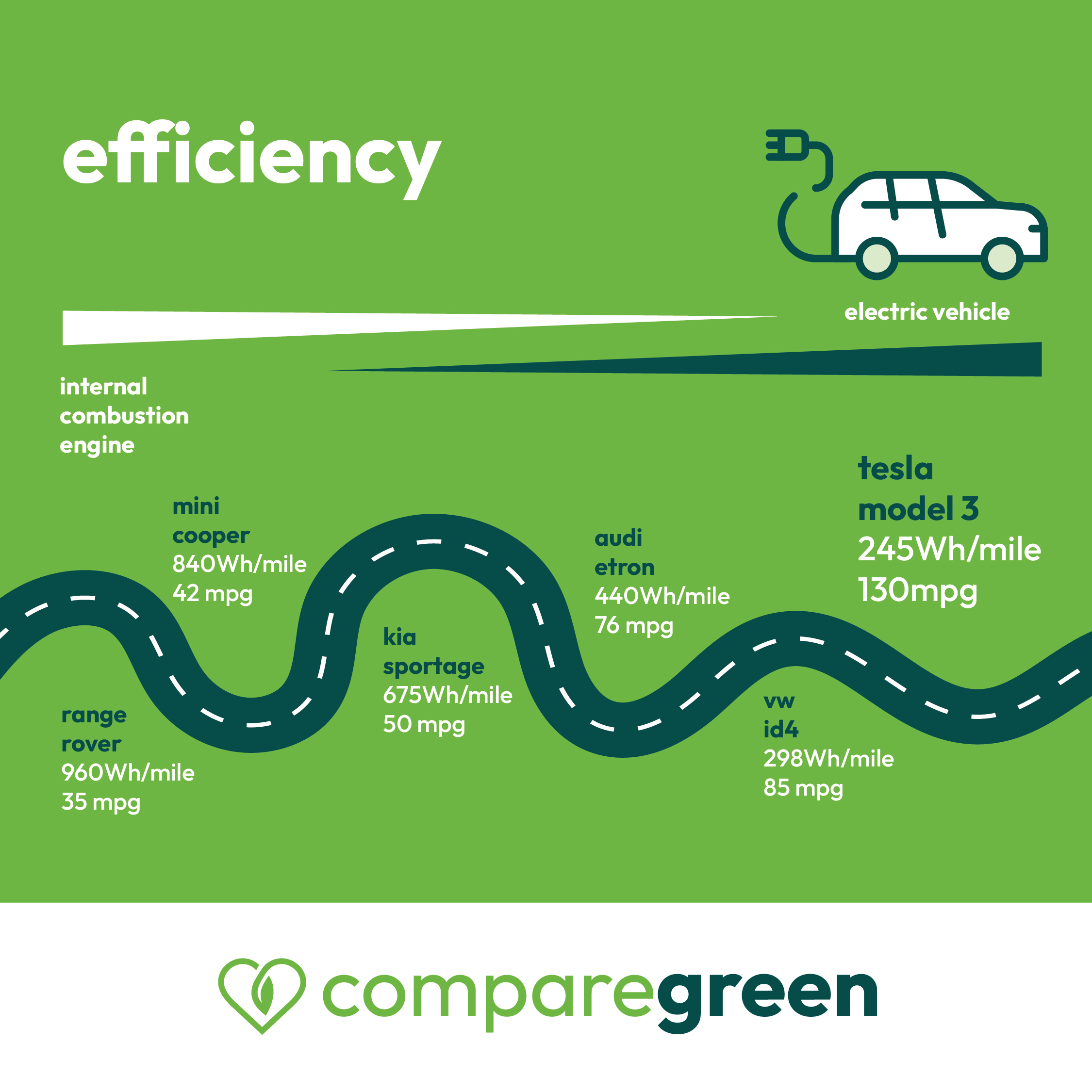Why are EVs more efficient?
Electric cars are far more efficient than fossil fuelled vehicles in terms of fuel used per mile. This is to do with the way the energy is extracted from the fuel and the losses made in the creation of the energy. Electric cars are both cheaper to run and kinder to the climate.
Efficiency of energy use
Where it comes to electric car efficiency, the first thing to look at is how energy comes from the ‘fuel’ such as a wind farm, gas power station or fossil fuelled engine. Diesel and petrol engines are both hot to touch and noisy. Both the noise and heat are energy that is not being turned into forward motion.
- A diesel engine will only turn around 30% of the available hydrocarbon energy into forward motion.
- Around 63% of diesel energy is wasted as heat with the rest lost as noise.
- An EV will turn around 77% of stored energy into forward motion.
Let’s compare efficiency to miles per kilowatt hour (kWh):
- The typical 325kWh per mile EV will do 3.1 miles per kWh
- A fossil fuelled car doing 50 miles to gallon (mpg) will get 1.2 miles per kWh
- A fossil fuelled car doing 40 mpg will get one mile per kWh
- The EV is getting roughly 124mpg – almost 2.5 times the efficiency of the 50 mpg diesel and more than triple the 40 mpg car.
It is also possible to run a petrol generator to power an electric car powertrain and still achieve far better mpg than a diesel. This is because it isn’t wasting fuel accelerating and decelerating.
In producing the electric car’s energy, a wind, gas or coal turbine will produce each kWh of energy far more efficiently than a diesel energy. Yes, even a coal powered electric car is more climate friendly than a petrol or diesel one.
Normal electric car driving is more efficient than petrol or diesel
Driving an EV is a different bag to driving a fossil fuelled vehicle:
- The faster you go, the more energy you consume.
- Fossil fuelled cars can consume similar amounts of fuel at 30 mph and 60 mph thanks to their gearbox
- In an electric car, you will use regenerative braking a lot – simply taking your foot off the accelerator to slow the car will recoup energy for the battery
- One-foot driving is possible in cities with the regenerative braking on a high setting so every time your foot is off the accelerator the vehicle slows quickly
- Acceleration is near instant and can be a lot of fun
- In most cases, with their weight low and in the middle of the car, they handle better in corners than fossil fuelled vehicles
Electric cars prefer town and country roads to motorways
Thanks to regenerative braking, it can arguably be more efficient to drive on country roads and on city streets than it is on motorways. Motorways were built for fossil fuelled cars that get similar efficiency at high speed as lower speeds.
Staying with electric car efficiency, by contrast, an EV using far more battery as you cruise at 70mph and won’t do much in the way of regenerative braking. If you’re not in a hurry – perhaps driving on holiday – then one of those routes with bends, towns and slower stretches could increase your range. Electric cars can claw back as much as 15% of energy per full battery discharge using regenerative braking. By comparison, on a clear motorway run at midnight you’ll rarely slow down and won’t get regenerative braking.
Hills can be a killer
The downside to the scenic route above is that smaller roads don’t have cuttings and will crest a lot of hills. EVs don’t like hills as the increased resistance of the climb, combined with the weight of the car, mean that hilly routes can consume more electricity. Using regenerative braking on the way down the hill can recapture much of that excess used but certainly not 100%.
Weather
Winter EV driving ranges are as much as 20% lower than summer. This is because cold batteries are less efficient at taking in and releasing energy.
Many cars can be pre-warmed in a garage when plugged into the charger, and programmed to warm the battery using mains electricity before you go out for the day. This can improve your electric car efficiency.
As with hills, headwinds can impact EV range, and so can rain. With these common enough weather conditions in mind, living in Northern Europe isn’t the best place for them! All electric car manufacturers do arctic testing to learn how to optimise the vehicle in the most difficult conditions.
What does the future hold?
Battery efficiency is a key battleground for car manufacturers.
Never mind the Tesla Sportster, possibly the best looking electric car ever designed is the Mercedes EQXX concept car. Redolent of the Jaguar E-Type, this car has been built with efficiency in mind from the shape of the shell right down to the way that the battery is cooled with airflow from the grille.

The average electric car can do around 3.1 miles per kWh. The EQXX can manage double this. Mercedes’ scientists are setting a benchmark for efficiency in the electric vehicle world.
Compare the efficiency of electric cars here courtesy of EV database.



